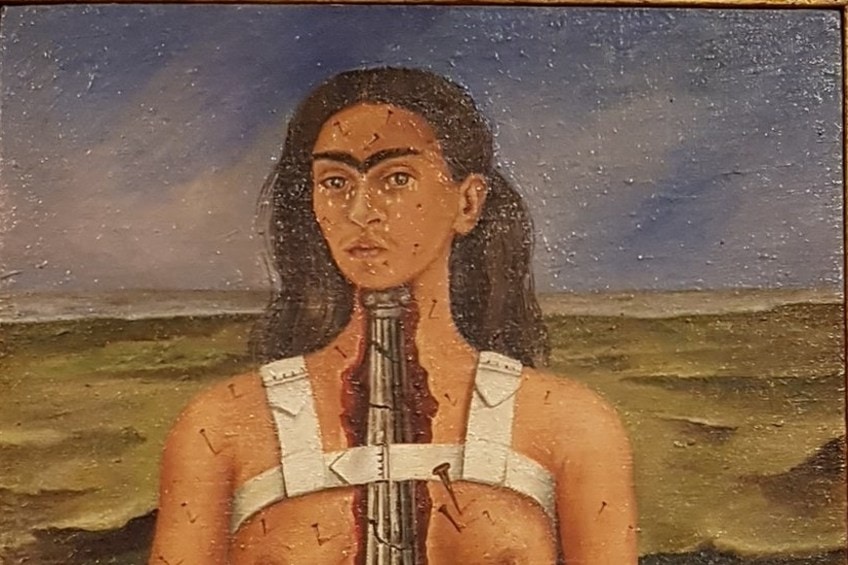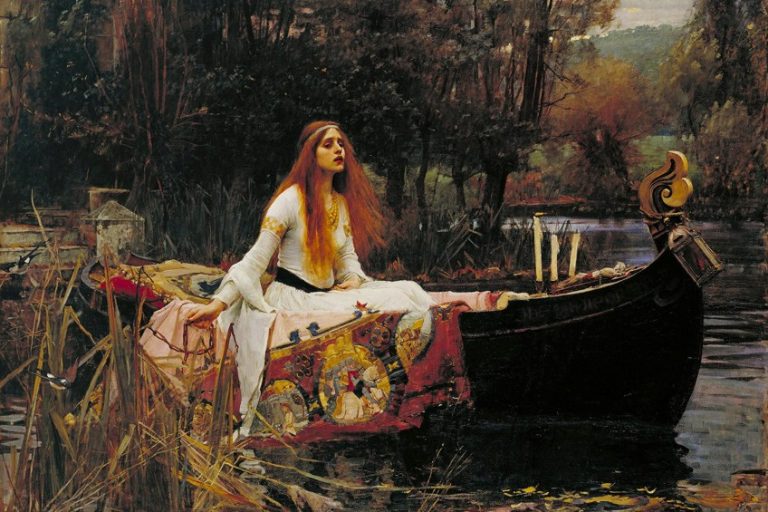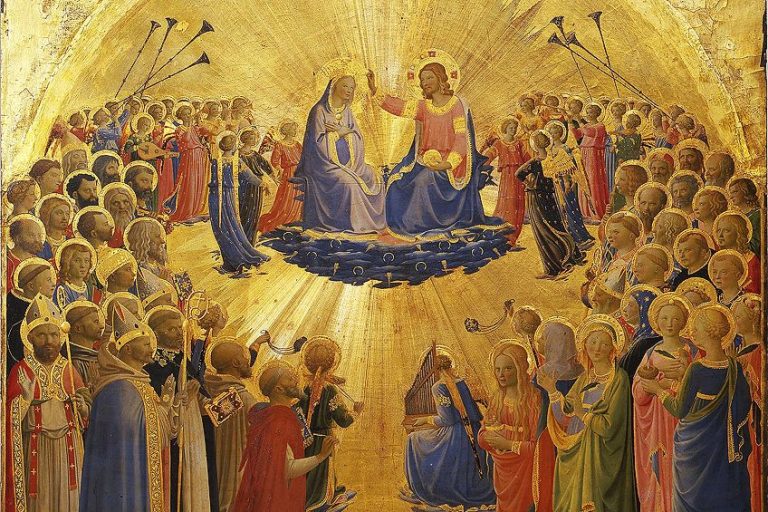“The Broken Column” Frida Kahlo – Analyzing “La Columna Rota”
Although her dreams of being a doctor were never realized, Frida Kahlo became a healing force for so many through her paintings. She was an inspiring artist and confident in portraying self-portraits that explored her deep pains, traumas, and alter egos. Building a bridge with her paintbrush, she provided so many, especially women, with comfort and the raw truth that they are not alone in what they are going through or who they are. Below we look at one example of many of these self-portraits of and by Kahlo, called The Broken Column (La Columna Rota) (1944).
Artist Abstract: Who Was Frida Kahlo?
Magdalena Carmen Frida Kahlo y Calderón, more commonly known as Frida Kahlo, was born on July 6, 1907, in a town called Coyoacán, which is just outside of Mexico City. The home she lived in with her family was La Casa Azul, meaning “The Blue House”. She wanted to study medicine as a child, but her career took a different turn when she was critically injured in a bus accident at 18 years old.
As a result of this accident, she taught herself art.
She had an avid interest in politics and was part of the Mexican Communist Party (PCM). In 1929 she married artist Diego Rivera. She was known for painting self-portraits and exploring Mexican folk culture and Aztec mythology; her artworks explored reality and fantasy. She died of a pulmonary embolism in 1954, but some suspect it may have been suicide.
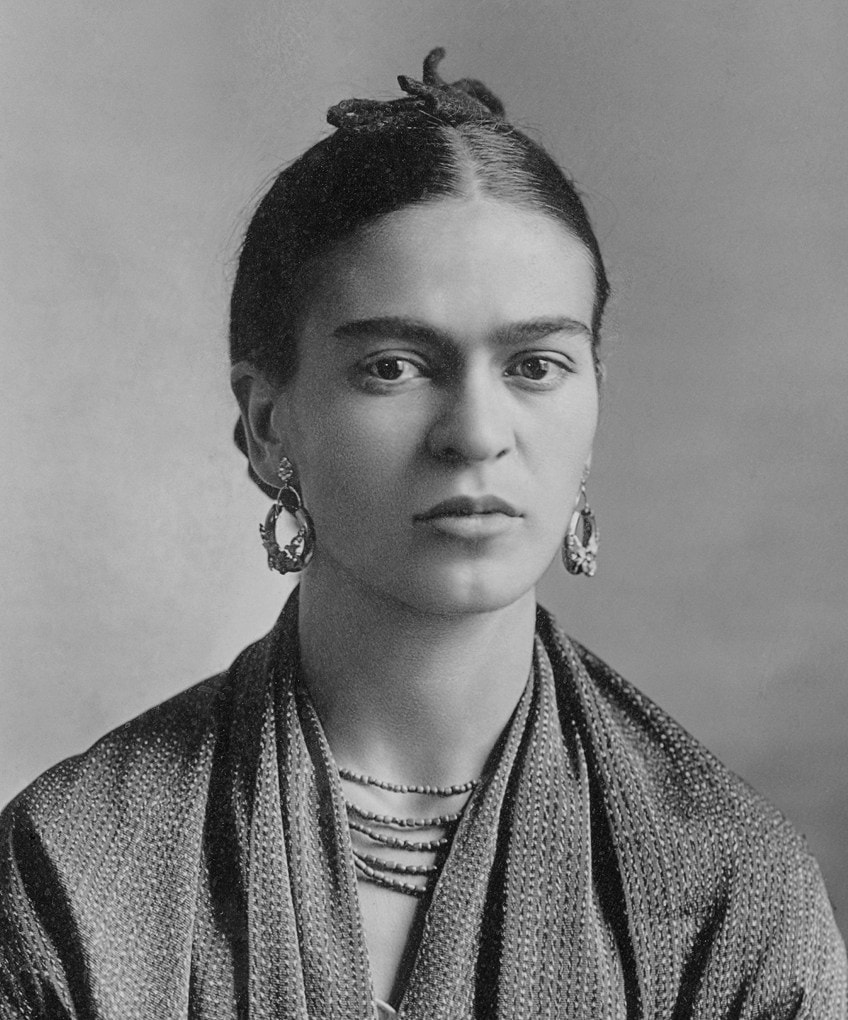
The Broken Column By Frida Kahlo In Context
In The Broken Column, Frida Kahlo presents herself in all her rawness – we see tears, pins, and pain. This is just one example of many that Kahlo created. Below, we look at this painting in more detail and how the self-taught artist depicted herself in what was almost a decade before she died.

We will start with a brief contextual analysis, discussing various socio-historical influences and circumstances about Kahlo and how these have shaped her painting style and subject matter. We will then discuss the above-mentioned painting, titled La Columna Rota in Spanish, and look at the subject matter and formal elements like color, perspective, and so forth.
| Artist | Frida Kahlo |
| Date Painted | 1944 |
| Medium | Oil on Masonite |
| Genre | Self-portrait painting |
| Period / Movement | Surrealism, Magical Realism, Mexicayoti movement |
| Dimensions | 39.8 x 30.6 centimeters |
| Series / Versions | Not applicable |
| Where Is It Housed? | Museo Dolores Olmedo, Xochimilco, Mexico City, Mexico |
| What It Is Worth | Not available |
Contextual Analysis: A Brief Socio-Historical Overview
Frida Kahlo experienced many hardships throughout her life, but possibly one of the most fatal and lifelong was when she was 18 years old. Apparently, when Kahlo was on the way home from school on a bus, it collided with a car, of which she almost lost her life along with others. She endured and suffered a metal handrail impaled through her pelvic hip area. This left her bedridden in hospital, reportedly for a month, and then several months after at home.
This collision would prove to become Kahlo’s lifelong pain and trauma, but possibly also a very unfavorable and unfortunate muse that would poke at her to paint every day.
This led to the creation of a sort of broken woman art, not only to alleviate her pain, but which would also create an outlet for so many other women going through their own form of pain, whether physical, physiological, or psychological.
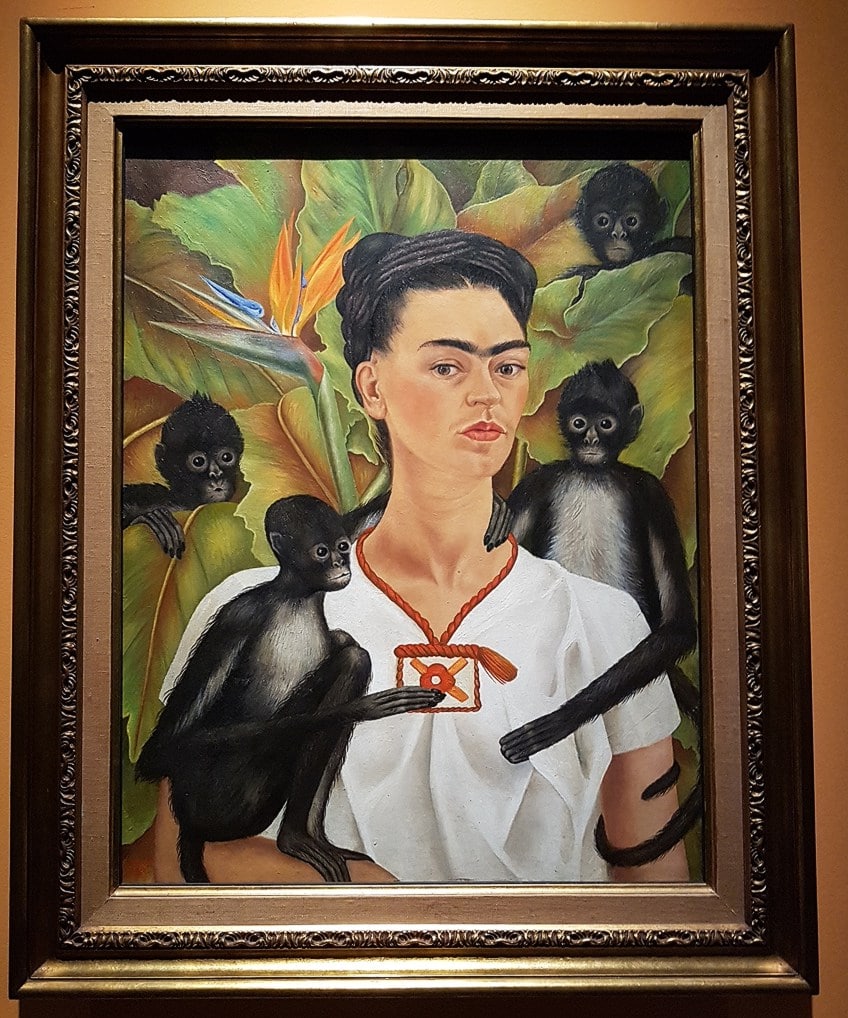
During her recovery period, she was given an easel and oil paints by her parents, the easel was made to suit her in bed during her healing process. She started painting and produced numerous self-portraits and portraits of her relatives, like her sister, and friends.
Her portraits made up a large portion of her art collection, she was also remembered as saying, “I paint myself because I am so often alone and because I am the subject I know best”.
However, she didn’t only paint portraits; she also explored the depths of ideas related to identity, culture, and life. It is important to note that Kahlo’s family also shared a different cultural lineage; her father was originally from Germany who moved to Mexico when he was a young boy. Her mother had both indigenous heritage and Spanish heritage. This also led Kahlo to explore her mother’s heritage when she traveled with her then-husband, Diego Rivera.
Frida Kahlo Influences
It is worth noting that Frida Kahlo had numerous artistic influences throughout her art career. Although she always enjoyed art, from a young age, she was mostly self-taught but learned from many. Starting when she was in her teenage years, she apprenticed as an engraver for Fernando Fernandez, who was an acquaintance to her father and who also taught her drawing.
Kahlo’s father was a photographer, and this would also prove to be an area where she learned artistic skills like observation through the people who posed for photographs. Here she also reportedly learned to touch up photographs with a paintbrush. This early experience undoubtedly aided Kahlo in how she in turn observed and depicted herself and others in her paintings.
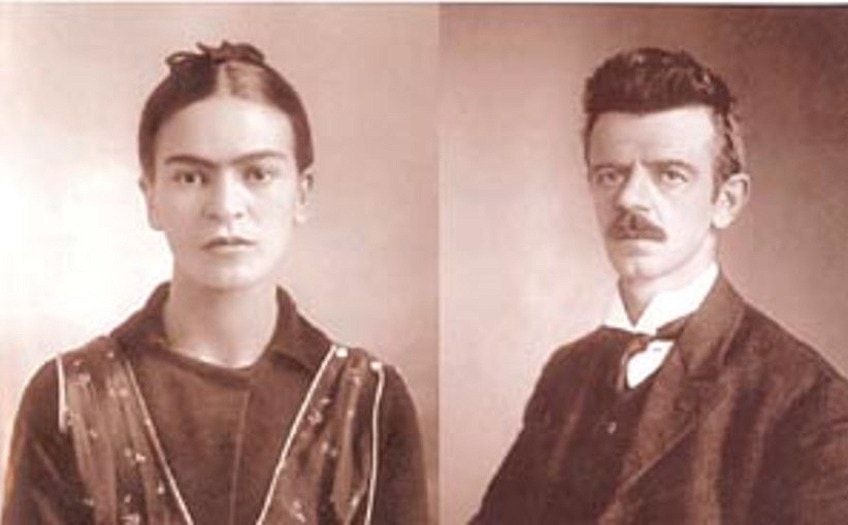
When Frida studied at the Antiguo Colegio de San Ildefonso she became part of the group called Los Cachuchas. The members followed the tenets of the Stridentism movement, which was known as an avant-garde and artistic movement, developed after the Mexican Revolution and inspired by other art movements like Dadaism.
These movements influenced Kahlo’s perceptions and ultimately her style too.
She was inspired by artists like Amedeo Modigliani, Marcel Duchamp, Max Ernst, Giorgio de Chirico, and many others. An example of one of her stylistic explorations, Self-portrait in a Velvet Dress (1926), depicts her with an elongated neck reminiscent of Modigliani’s elongated necks.
One of Kahlo’s most important influences was the Mexican artist, Diego Rivera. He inspired Kahlo to embrace her Mexican heritage through his own pursuits to add to his collection of cultural pieces. Furthermore, Kahlo also traveled to and lived in the United States with Rivera, for example, places like New York, San Francisco, and Detroit.
Kahlo reportedly met another prominent female artist during her stay in New York, known as the “Mother of American Modernism”, Georgia O’Keeffe. Other artworks Kahlo experienced were from Salvador Dalí, El Greco, and others. These she would have viewed at prominent art galleries like the Museum of Modern Art and the Metropolitan Museum of Art.

Another well-known artist Kahlo met during 1938 was the Surrealism co-founder, André Breton. He proved a catalyst for the success of Kahlo’s paintings and helped her set up an exhibition in New York at the Julien Levy Gallery. This was Kahlo’s first solo exhibition and she sold numerous paintings.
She also exhibited in Paris, during 1939 as per Breton’s invitation, however, this was a collective exhibition at the gallery called Renou et Colle. During the 1940s Kahlo continued to exhibit in various prominent art museums in the United States and she became a well-known artist in Mexico, with commissions by the Ministry of Public Education.
Kahlo’s artwork became emblems of Mexican culture.
Was Frida Kahlo Really a Surrealist?
While many associate Frida Kahlo with the art movement Surrealism, and she was involved in the style having met André Breton, one of the co-founders of Surrealism, she did not distinguish herself as specifically Surrealist. Breton has been widely quoted as describing Kahlo’s works as a “ribbon around a bomb”. When Breton visited Diego Rivera in Mexico in 1938, he saw her artwork and is reported as remarking about her work being Surrealist.
Kahlo has been quoted as saying, “They thought I was a Surrealist, but I wasn’t. I never painted dreams. I painted my own reality”.
She was closely related to being a Magical Realist, which is different from Surrealism, the latter having more to do with depicting elements from dreams and the unconscious. Although Frida Kahlo’s artwork was close to being Surrealist, she was also acquainted with many Surrealists in America and Paris, it is important to remember that her artwork draws from and fits into many different art movements. The art world has placed her into Surrealism where it has not been completely accurate to do so.
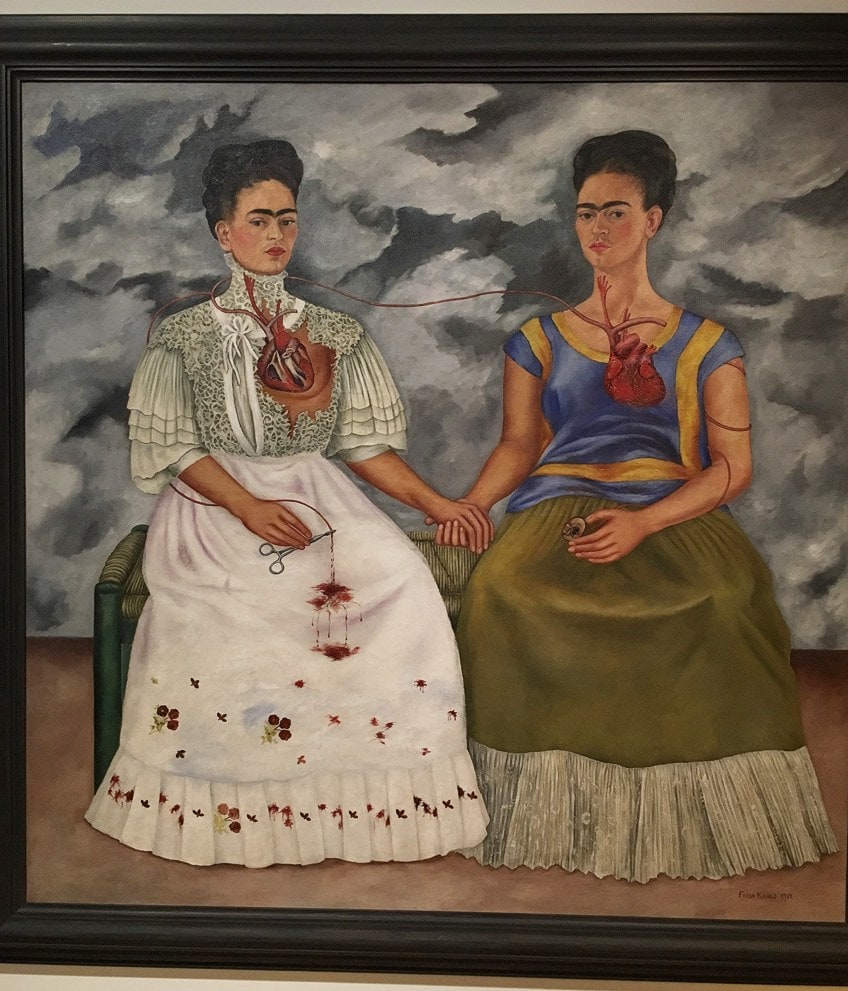
Formal Analysis: A Brief Compositional Overview
Frida Kahlo’s artwork has been seminal to 20th-century art and culture, not only has it been an important marker for Mexican culture and heritage, showing symbolic significance through Kahlo’s many motifs like monkeys and dogs, but it has been a significant player for the Feminist art movement.
Kahlo’s self-portraits are emblems showing her inner world. She brings her whole self, broken and beautiful, to the canvas, and allows other women to do the same. Through this process, she somehow, stylistically, pieces all her puzzles together whether it is physical brokenness or emotional trauma.
Let us look at how she presents herself in what is reportedly one of her most touching paintings ever completed.
Subject Matter
In The Broken Column Frida Kahlo stands facing us, the viewers, her gaze is seemingly unbroken as she looks ahead; her head is slightly tilted to her right (our left). Her long hair lies loose behind her back, and she has a darkened and clear monobrow accentuating her facial features.
We can only see the upper part of her torso, which is naked, braces covering her body like a metal corset. Her hips and legs are covered by a flowing white sheet bedecked with areas of blood. She gently holds onto the sheet with both her hands that are down by her sides. Her upper torso is bare, and her breasts are uncovered.
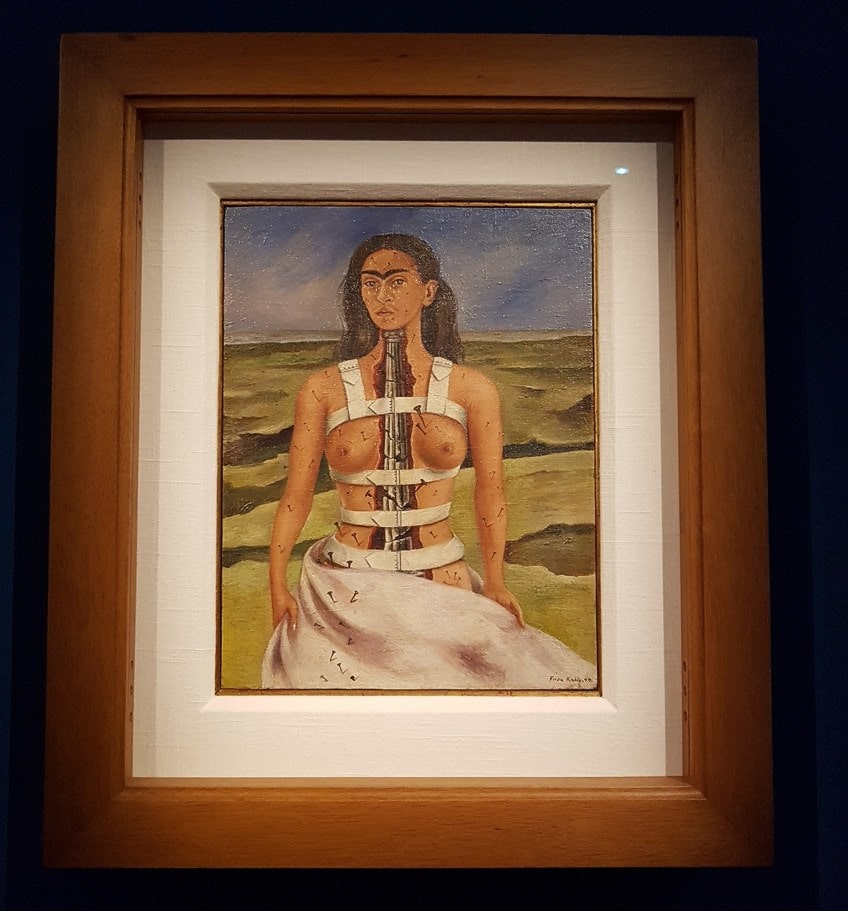
But Kahlo goes one step further and bares her entire insides to us, her skin torn open along the midline of her torso revealing a grey stone-colored Ionic column in the center of her torso where we would expect her spine to be.
This Ionic column is in fact placed to represent her spine. If we look closer, the column is cracked and seemingly starting to fall apart. There appear to be six large cracks along the column.
There are two other aspects of how Kahlo portrayed herself here. First, there are numerous tears running from her eyes and down her cheeks as she stares at us. Second, there are nails pinned into her skin all over her body, including the white sheet that covers her lower torso, these are running down the right side of her lower torso, which would be down her right leg. This could be hinting at when she had polio when she was younger, and her right leg was affected as a result.
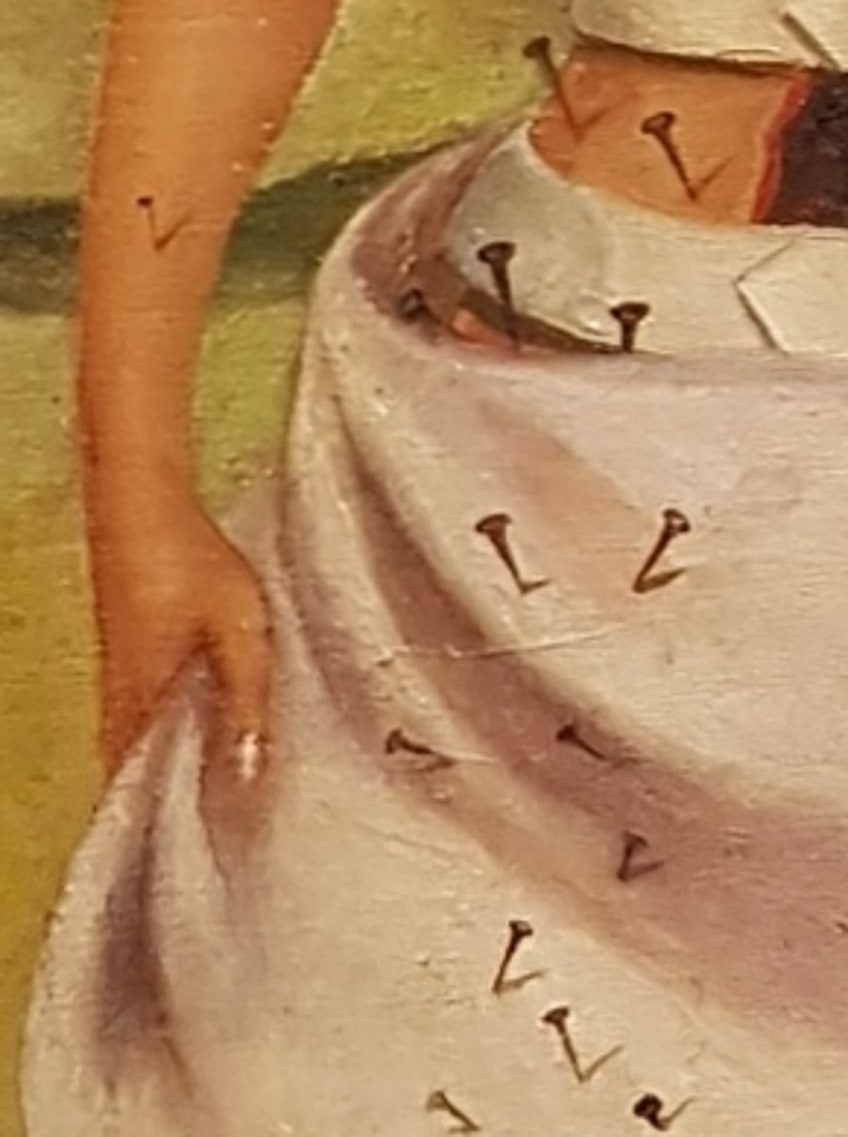
The above-mentioned give the impression that Kahlo is covered in pain, the pins symbols of this, but what makes it more intense is her seemingly calm composure and silent tears, as if she is unable to do anything and is consumed by it.
The background appears empty and desolate, we see green strips of land, echoing the bands of the metal corset around Kahlo’s torso, and a blue sky. She is also the only figure we see in this vast landscape, which emphasizes her aloneness. La Columna Rota was painted in 1944, and as mentioned, it was almost a decade before Frida Kahlo’s death.
She had a spinal operation before she painted this image of her own isolated reality, and she was made to wear the metal corset as part of her recuperation and support for her back after surgery.
We see the visual imagery in this painting as indicators of what Kahlo went through in her real life, which was ongoing chronic pain. Her paintings have been almost like visual diaries with elements of the abstract and surreal, but ultimately, not difficult to empathize with her pain.
Color and Light
The colors in The Broken Column painting are mostly greens, blues, whites, and the lighter brown of Kahlo’s skin complexion – all-natural and subdued colors. She often utilized brighter colors, which come from the bright colors of Mexican art and culture.
However, in The Broken Column Frida Kahlo creates a kind of contrast; the deeper earthy browns and greens from the ground and the blues from the sky comprising the background are setting up the similar earthy browns and reds from her skin tone and hair, which is a dark shade of what appears to be brown.
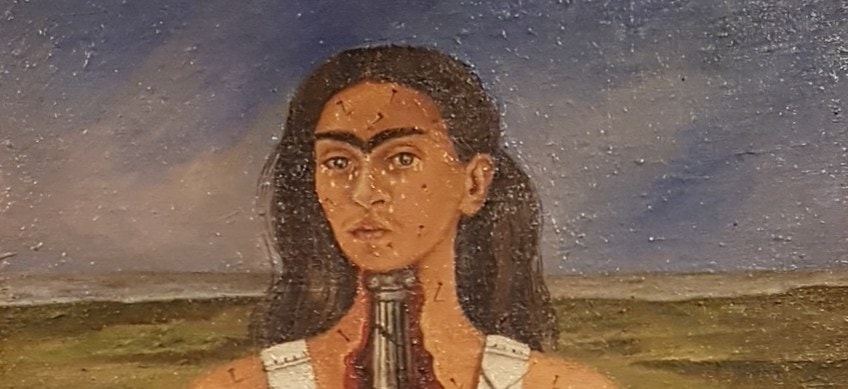
The white of the covering around Kahlo’s lower torso is also seemingly echoed in the whites of the clouds in the sky, both of which have diaphanous qualities. However, we do see some reds on the white covering around Kahlo, and these are echoed with the patches of browns we see on the green in the background.
It is almost as if the background and Kahlo in the foreground mirror one another in their qualities, which we can see played out in the way Kahlo applied her paints and created the textures.
Perspective and Line
Kahlo also creates a strong focus on horizontal lines in the composition. Again, we see a mirroring effect between the background and foreground. The horizontal lines from the cracked earth behind Kahlo are echoed in the horizontal lines from her metal corset around her upper torso. Furthermore, we can draw similarities from the shape of her monobrow and the shapes of the cracks in the earth behind her, which appear almost wave-like.
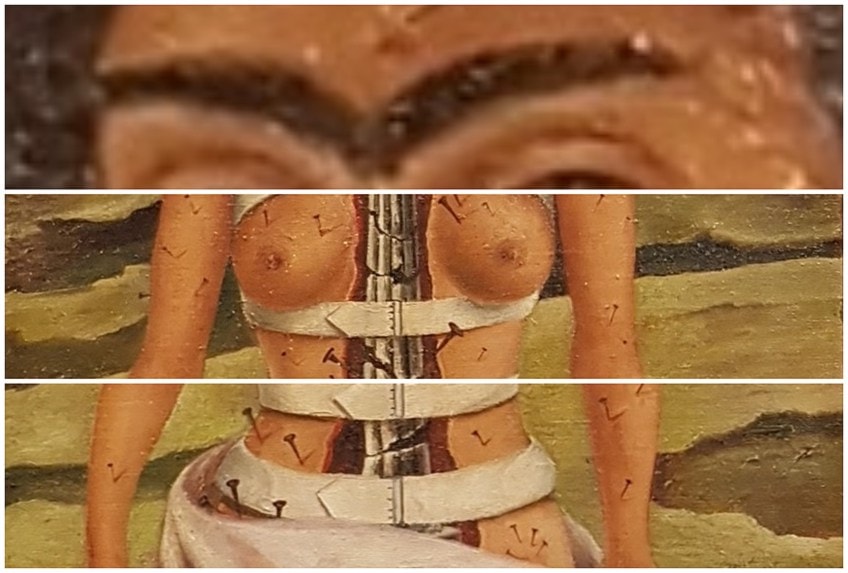
The horizon line in the background appears slightly diagonal and slanted, which gives the landscape a slanted appearance behind her. This creates a very subtle sense of chaos, as if the land behind her is falling apart or moving, which is undoubtedly a reflection of Kahlo’s inner state. Here the background and foreground mirror one another again.
Could we even go as far as to say that Kahlo is the background, and the background is Kahlo?
Stylistically, Kahlo creates spatial depth and three-dimensionality in her delineation of the cracks in the earth behind her, which creates the vast extending landscape behind her. She created this by depicting the nearest cracks in the earth as bigger and as we gaze further ahead these diminish in size. Furthermore, we see slight shadows cast by each pin in Kahlo’s skin, and their direction suggests a light source coming from a certain direction.
Symbolism
There have been numerous suggested symbolic references in The Broken Column, namely the white covering around Kahlo’s torso and the nails in her skin, which point to religious symbols. Kahlo often depicted herself in a religious context, which was understandable because she had a stringent religious upbringing, especially from her mother.
For example, she would depict herself as the Mother Mary or Jesus Christ as well as Saint Sebastian, who was a Christian martyr. She painted her own image with the likeness of holiness we would see in images and icons of Mother Mary and Jesus Christ. In The Broken Column, the white covering could suggest the covering Jesus Christ utilized and the nails in her skin echo the nails that Jesus had pinned through his hands and feet on the cross.
Kahlo is undergoing her own form of crucifixion and becomes the martyr herself.
With regards to martyrdom, she could also be mirroring Saint Sebastian, who was tied to a tree and had arrows shot into him. This is an image that has become widely associated with the Christian saint and Kahlo associates herself with a similar image. Instead, here she is impaled by the nails also covering her whole body as the arrows did on Saint Sebastian.
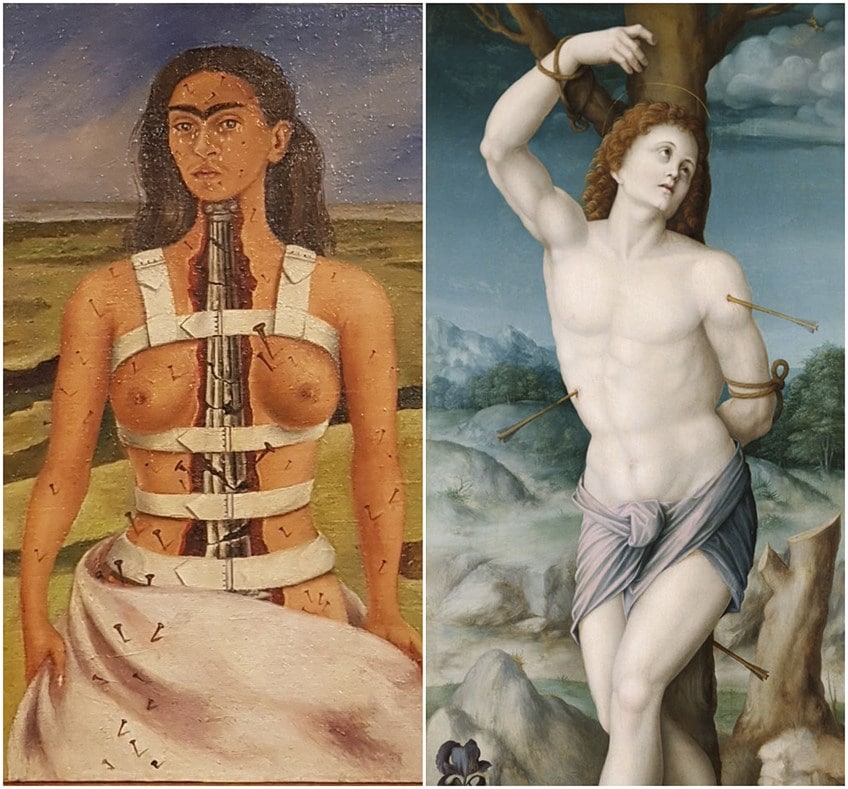
Frida Kahlo: Broken, But Beautiful
On her deathbed, Kahlo was remembered as having drawn a black angel in her diary with the words, “I joyfully await the exit – and I hope never to return – Frida”. She was an artist who depicted herself in many of her broken ways, her chronic pain was a major part of this. She continued to paint and protest until she could no longer. In 1953 she exhibited at the gallery of Lola Alvarez Bravo.
She lay on her bed, which was brought to the gallery and placed in the center of the space during the opening of the exhibit. This was Kahlo’s last exhibition, and she died the following year of what was thought to be a pulmonary embolism, but some suspect she died of an overdose on her painkillers.
Frida Kahlo was an inspiration to many, not only artists. She still is one of the most renowned artists from the 20th century, in Mexico and the United States. There have been numerous exhibitions in her honor, for example, in 2014 the Museum of Contemporary Art Chicago displayed Unbound: Contemporary Art After Frida Kahlo, there have also been other exhibitions in London and Mexico. Furthermore, there have been numerous biographies written about Kahlo and her artwork has become a touchstone for other female artists.
Although she depicted herself in her brokenness, a sort of broken woman art, she always remained beautiful. Just one example, as we see in “The Broken Column” painting, she may be in pain and pieces, but she has a quality of sensuality that seeps into the cracks and makes her something more – someone beautiful.
Take a look at our The Broken Column webstory here!
Further Readings
Frequently Asked Questions
What Does The Broken Column Painting Mean?
The Broken Column (1944) painting by Frida Kahlo was painted as a visual image of Kahlo’s chronic pain, which was a result of her spinal surgery from a fatal car accident she was in when she was 18 years old. Her chronic pain is portrayed by the nails all over her skin, the tears running down her cheeks, and the Ionic column revealed by the large area of skin cut open running down her front torso. She appears naked, braces around her torso appearing like a metal corset to hold her in place.
Was Frida Kahlo a Surrealist?
Frida Kahlo was not a Surrealist per se, but she was influenced by various Surrealist artists, including André Breton, whom she met and collaborated with. She was also classified as a Magical Realism and Primitivism, or Naïve Art, painter. She was also part of the Mexicayoti movement, which sought to “revive” the ancient Mexican heritage. Her artwork has not been part of a specific art movement but drew from various art styles, which made her unique.
What Characterizes Frida Kahlo’s Art?
Frida Kahlo painted her reality the way she felt and saw it, she became well-known for her self-portraits, which explored her life and traumas she experienced, notably, her car accident that damaged her spine and left her incapable of giving birth to a child as well as a difficult relationship with her husband, Diego Rivera. She included various motifs and symbols that all related to her physical and emotional pains. While her self-portraits made up a large part of her painting collection, she also created other figurative paintings.
Alicia du Plessis is a multidisciplinary writer. She completed her Bachelor of Arts degree, majoring in Art History and Classical Civilization, as well as two Honors, namely, in Art History and Education and Development, at the University of KwaZulu-Natal, South Africa. For her main Honors project in Art History, she explored perceptions of the San Bushmen’s identity and the concept of the “Other”. She has also looked at the use of photography in art and how it has been used to portray people’s lives.
Alicia’s other areas of interest in Art History include the process of writing about Art History and how to analyze paintings. Some of her favorite art movements include Impressionism and German Expressionism. She is yet to complete her Masters in Art History (she would like to do this abroad in Europe) having given it some time to first develop more professional experience with the interest to one day lecture it too.
Alicia has been working for artincontext.com since 2021 as an author and art history expert. She has specialized in painting analysis and is covering most of our painting analysis.
Learn more about Alicia du Plessis and the Art in Context Team.
Cite this Article
Alicia, du Plessis, ““The Broken Column” Frida Kahlo – Analyzing “La Columna Rota”.” Art in Context. November 15, 2021. URL: https://artincontext.org/the-broken-column-frida-kahlo/
du Plessis, A. (2021, 15 November). “The Broken Column” Frida Kahlo – Analyzing “La Columna Rota”. Art in Context. https://artincontext.org/the-broken-column-frida-kahlo/
du Plessis, Alicia. ““The Broken Column” Frida Kahlo – Analyzing “La Columna Rota”.” Art in Context, November 15, 2021. https://artincontext.org/the-broken-column-frida-kahlo/.


